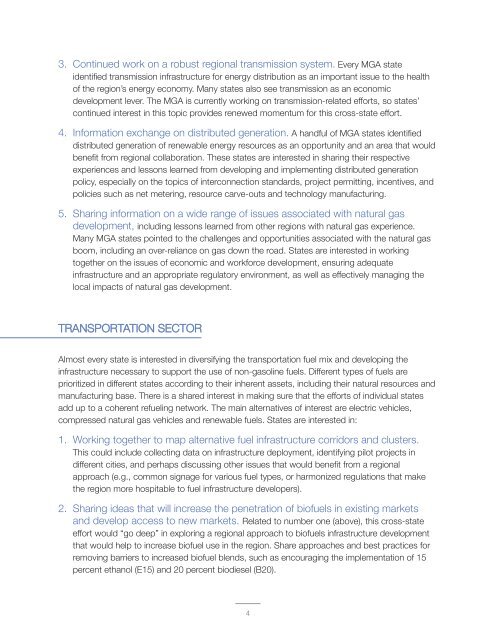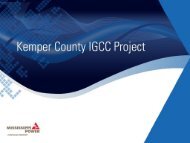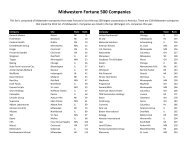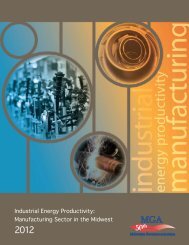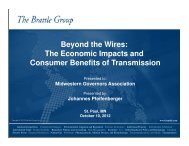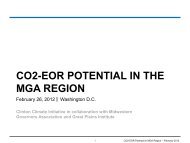Energy Action Paper - Midwestern Governors Association
Energy Action Paper - Midwestern Governors Association
Energy Action Paper - Midwestern Governors Association
Create successful ePaper yourself
Turn your PDF publications into a flip-book with our unique Google optimized e-Paper software.
3. Continued work on a robust regional transmission system. Every MGA state<br />
identified transmission infrastructure for energy distribution as an important issue to the health<br />
of the region’s energy economy. Many states also see transmission as an economic<br />
development lever. The MGA is currently working on transmission-related efforts, so states’<br />
continued interest in this topic provides renewed momentum for this cross-state effort.<br />
4. Information exchange on distributed generation. A handful of MGA states identified<br />
distributed generation of renewable energy resources as an opportunity and an area that would<br />
benefit from regional collaboration. These states are interested in sharing their respective<br />
experiences and lessons learned from developing and implementing distributed generation<br />
policy, especially on the topics of interconnection standards, project permitting, incentives, and<br />
policies such as net metering, resource carve-outs and technology manufacturing.<br />
5. Sharing information on a wide range of issues associated with natural gas<br />
development, including lessons learned from other regions with natural gas experience.<br />
Many MGA states pointed to the challenges and opportunities associated with the natural gas<br />
boom, including an over-reliance on gas down the road. States are interested in working<br />
together on the issues of economic and workforce development, ensuring adequate<br />
infrastructure and an appropriate regulatory environment, as well as effectively managing the<br />
local impacts of natural gas development.<br />
TRANSPORTATION SECTOR<br />
Almost every state is interested in diversifying the transportation fuel mix and developing the<br />
infrastructure necessary to support the use of non-gasoline fuels. Different types of fuels are<br />
prioritized in different states according to their inherent assets, including their natural resources and<br />
manufacturing base. There is a shared interest in making sure that the efforts of individual states<br />
add up to a coherent refueling network. The main alternatives of interest are electric vehicles,<br />
compressed natural gas vehicles and renewable fuels. States are interested in:<br />
1. Working together to map alternative fuel infrastructure corridors and clusters.<br />
This could include collecting data on infrastructure deployment, identifying pilot projects in<br />
different cities, and perhaps discussing other issues that would benefit from a regional<br />
approach (e.g., common signage for various fuel types, or harmonized regulations that make<br />
the region more hospitable to fuel infrastructure developers).<br />
2. Sharing ideas that will increase the penetration of biofuels in existing markets<br />
and develop access to new markets. Related to number one (above), this cross-state<br />
effort would “go deep” in exploring a regional approach to biofuels infrastructure development<br />
that would help to increase biofuel use in the region. Share approaches and best practices for<br />
removing barriers to increased biofuel blends, such as encouraging the implementation of 15<br />
percent ethanol (E15) and 20 percent biodiesel (B20).<br />
4


